Kodak 35mm delivers visual panache to 'Star Wars: The Rise of Skywalker'
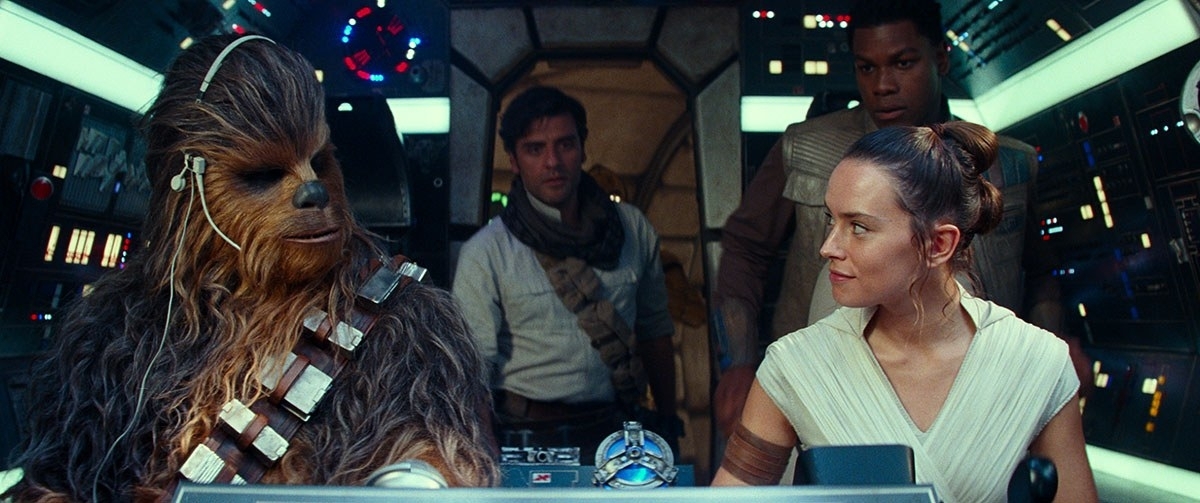
Joonas Suotamo is Chewbacca, Oscar Isaac is Poe Dameron, Daisy Ridley is Rey and John Boyega is Finn in "STAR WARS: THE RISE OF SKYWALKER." Photo by Lucasfilm. © 2019 and TM Lucasfilm Ltd. All Rights Reserved.
Over the last four decades, the Star Wars franchise has achieved a legendary status that most others can only dream about – never mind its financial success with earnings in excess of $9 billion for the movies themselves and a staggering $68 billion for its wider merchandising universe.
So when it came to filming Star Wars: The Rise of Skywalker, the ninth and concluding episode of the epic sci-fi saga first created by George Lucas in 1977, director J.J. Abrams and his regular cinematographer Dan Mindel BSC ASC knew they had to deliver something spectacular.
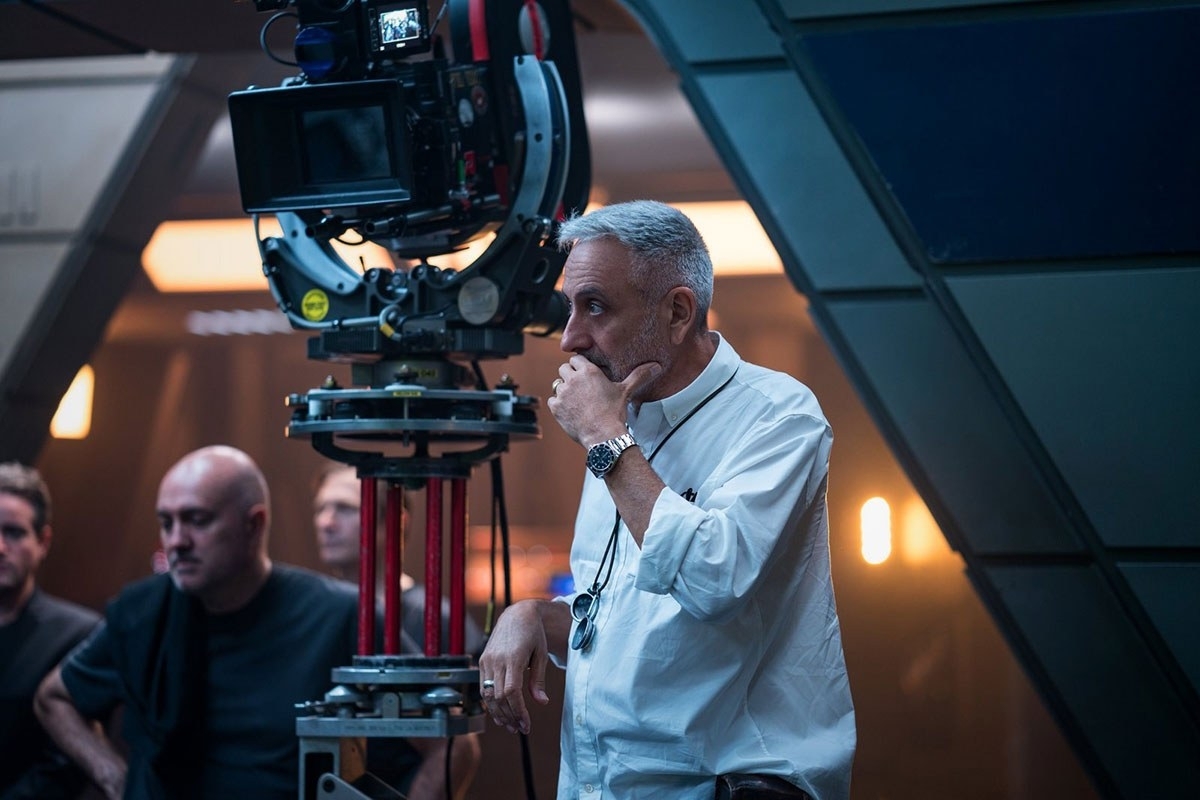
Cinematographer Dan Mindel BSC ASC on the set of "STAR WARS: RISE OF SKYWALKER." Photo by Jonathan Olley. © 2018 and TM Lucasfilm Ltd. All Rights Reserved.
“Star Wars is the mother of all sci-fi fantasy films, and we weren’t just facing an extraordinarily complex shoot from a technical point-of-view, we also had to honor and protect the legacy of what had gone before, while making an original movie in its own right,” says Mindel.
“As far as storytelling goes for the big screen, celluloid film remains the most texturized and powerful medium that exists. It gives you the opportunity to make a feature that will stand out against the sterility of other productions on our screens.
“I was determined, through the lighting, lenses and celluloid, to take Star Wars: The Rise of Skywalker to another level for audiences around the world and, hopefully, to excite other filmmakers as to stellar results film can deliver, whatever their budget.”
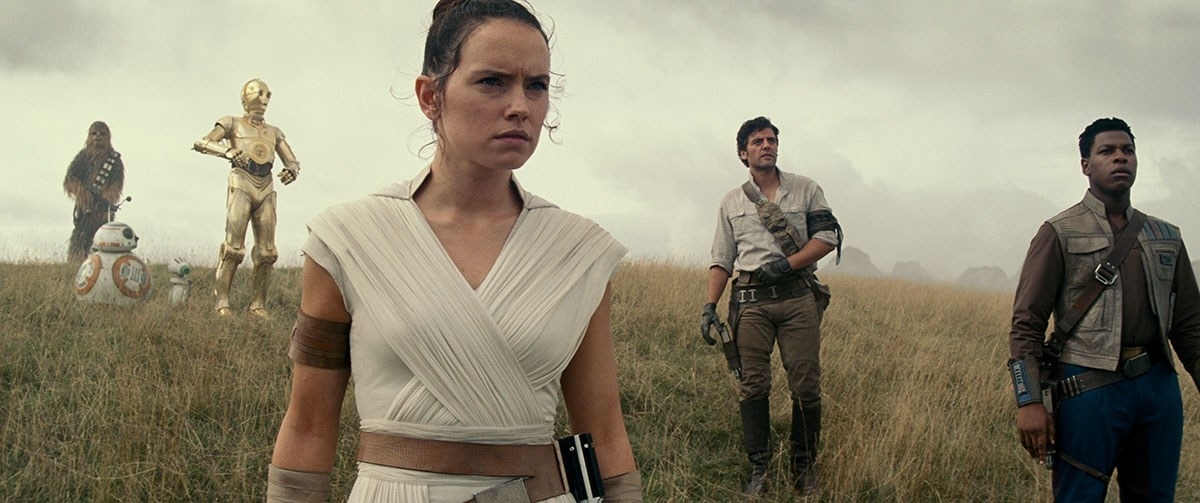
(Left to right) Chewbacca (Joonas Suotamo), BB-8, D-O, Rey (Daisy Ridley), Poe Dameron (Oscar Isaac) and Finn (John Boyega) in "STAR WARS: THE RISE OF SKYWALKER." Photo by Lucasfilm Ltd. © 2019 ILM and Lucasfilm Ltd. All Rights Reserved.
Peppered with pulsating intergalactic action, the story sees the remnants of The Resistance face The First Order in a final showdown, while also reckoning with the past and their own inner turmoil. Meanwhile, the ancient conflict between the Jedi and the Sith reaches its climax bringing the Skywalker saga to a definitive end.
The film stars Daisy Ridley as Resistance-member and last Jedi warrior Rey, Mark Hamill as last Jedi Master Luke Skywalker, John Boyega as Resistance fighter Finn, and Oscar Isaac as Poe Dameron, commander of the Resistance, as they pit their wits against Kylo Ren, the Supreme Leader of the First Order, played by Adam Driver.
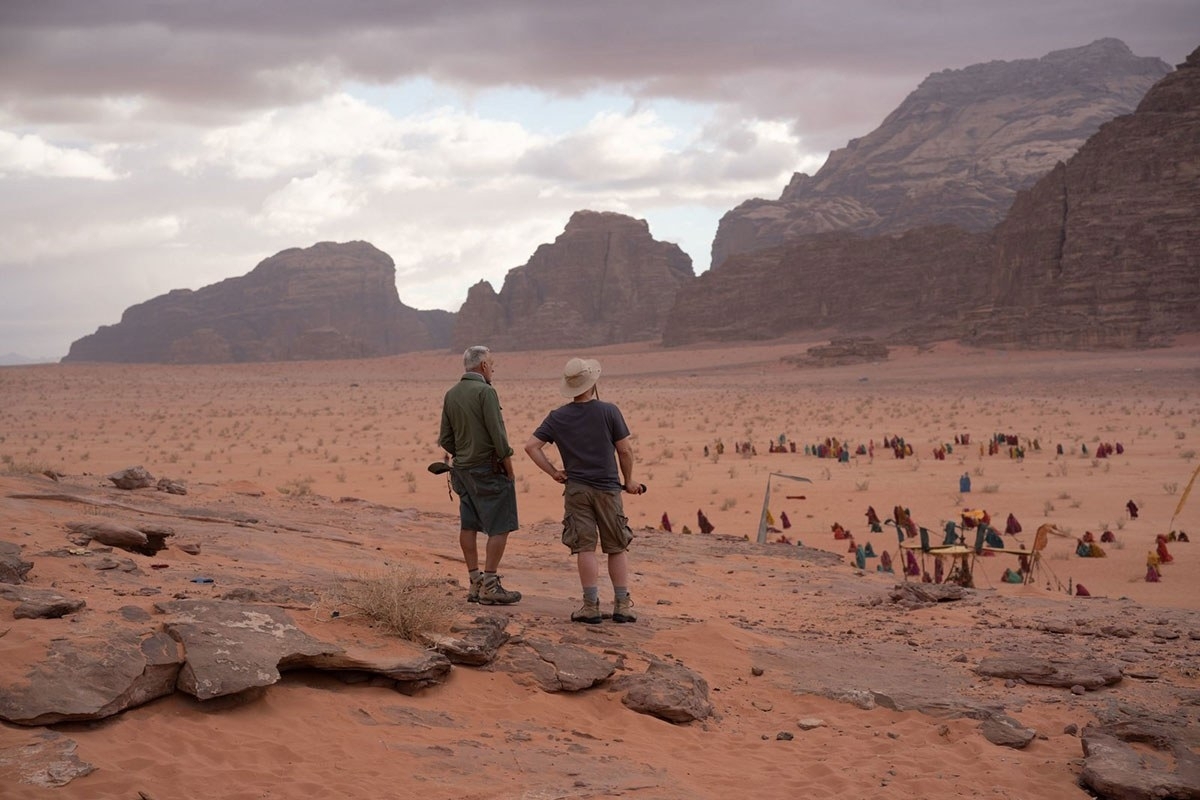
Cinematographer Dan Mindel BSC ASC (l) and director J.J. Abrams (r) in Wadi Rum, Jordan, during production on "STAR WARS: RISE OF SKYWALKER." Photo by Jonathan Olley. © 2018 and TM Lucasfilm Ltd. All Rights Reserved.
Star Wars: The Rise of Skywalker is Mindel’s fifth blockbuster production with Abrams following Mission: Impossible III (2006), Star Trek (2009), Star Trek Into Darkness (2013) and Star Wars: The Force Awakens (2017), which were all shot on film.
“J.J. is one of the most creative people you’ll ever meet and was perfectly content to let film weave its magic once again,” says Mindel, who also teaches best film practices to aspiring DPs at ASC Masterclasses and as part of his duties as Cinematographer-in-Residence at UCLA.
Principal photography in widescreen 2.40:1 on Kodak 35mm film took place over the course of 130 shooting days between August 2018 and February 2019, chiefly at Pinewood Studios and Cardington Studios in the UK, where a number of gigantic sets were constructed. These included The Resistance’s cavernous underground base, plus the interiors/exteriors of the Blockade Runner and Star Destoyer spaceships.
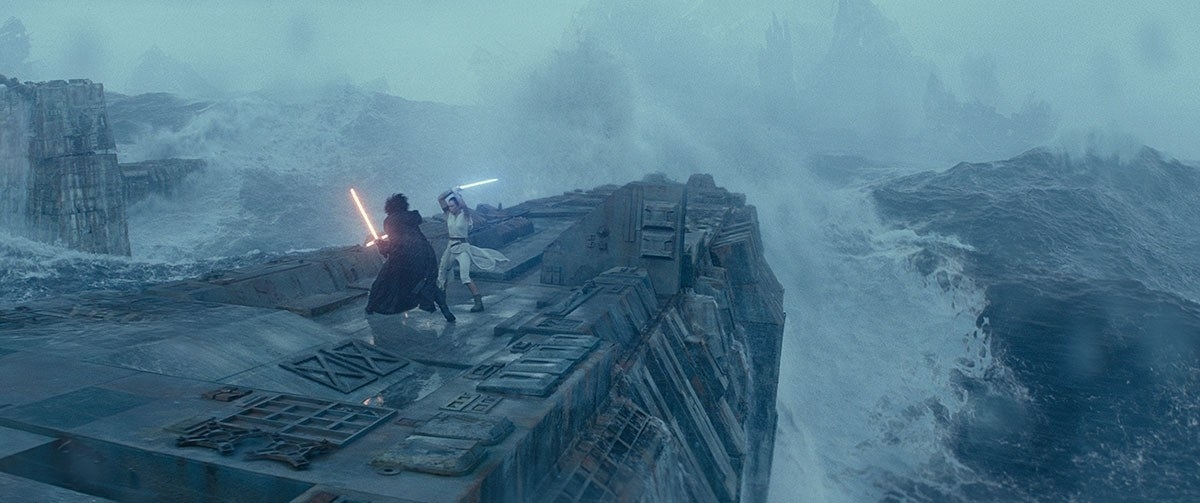
Adam Driver is Kylo Ren and Daisy Ridley is Rey in "STAR WARS: THE RISE OF SKYWALKER." © 2019 and TM Lucasfilm Ltd. All Rights Reserved.
Pinewood’s northern backlot and exterior water tank housed sets for the frigid, mountainous planet of Kijimi, and the light sabre fight on the deck of a Death Star space station adrift in the stormy ocean. Nearby Black Park was used for the movie’s jungle exteriors. Production also encompassed a stint in the sunshine at Wadi Rum, Jordan, where the movie’s desert scenes where filming involved as many as 1,000 cast and crew members.
Well-before production began, Mindel says he outlined his lighting strategy for the movie during a private dinner in L.A. amongst executives from MBS, which provided much of the illumination for the film, and his gaffer Perry Evans.
“Whether you are lighting a ravaged hero, such as Rey, or an evil adversary like Kylo Ren, the result has to look gorgeous and impactful on screen,” he says. “That’s what movies are all about, and that’s what would help to differentiate our production from the homogenous, indistinguishable formats being made. So, knowing that we were going to shoot on analog film, I revealed to my lighting team that I wanted to use analog fixtures on the actors.”
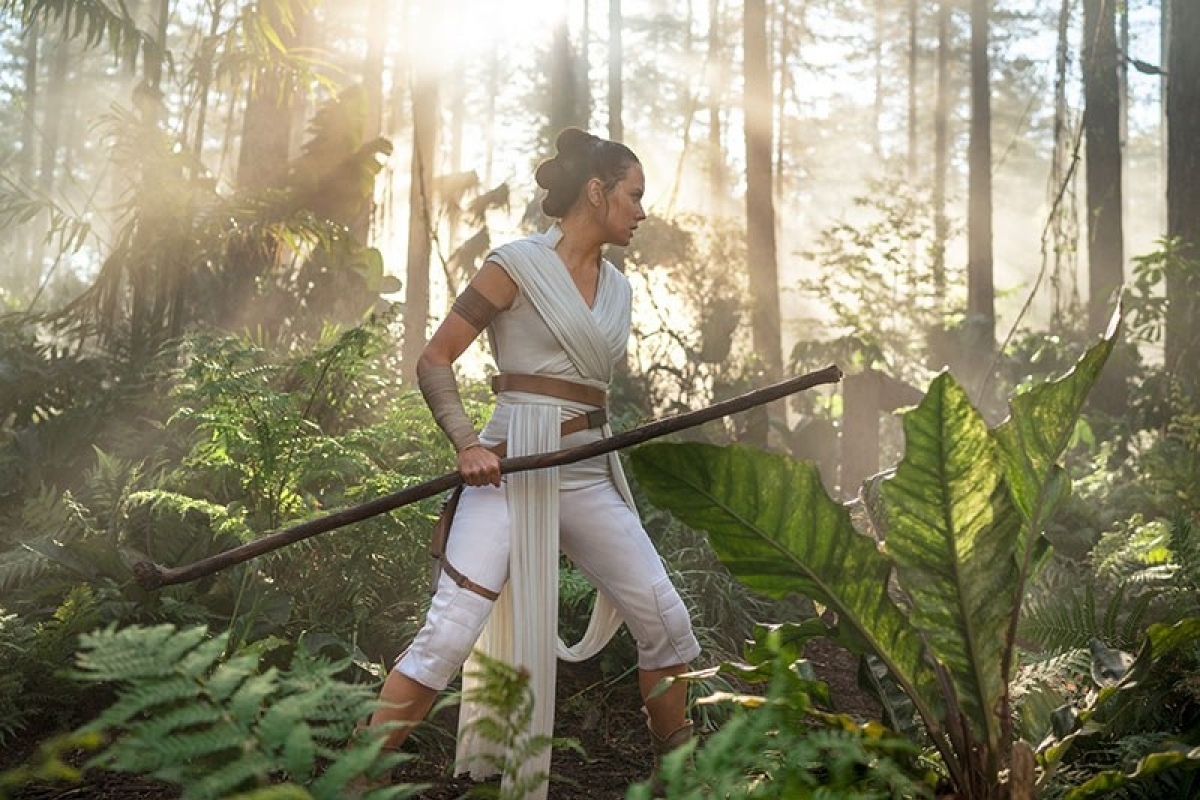
Rey (Daisy Ridley) in "STAR WARS: THE RISE OF SKYWALKER." Photo by Jonathan Olley. © 2019 and TM Lucasfilm Ltd. All Rights Reserved.
During production, while LEDs were used to illuminate large background swathes of the often very large sets, Mindel deployed an array of traditional sources – such as 20Ks, incandescents and focussed Fresnels – to bathe the actors in appropriately flattering or non-flattering analog light.
“It might be a cool idea to just use available light,” says Mindel, ”but if you want to make your own mark as a DP and to stamp your production with its own visual identity, it’s much more exciting and supportive to the actors to demonstrate a command of old-school photographic knowledge and filmmaking techniques.”
Working with Panavision’s teams in Woodland Hills, California, and Greenford, London, Mindel settled on the same combination of camera and lenses he used on Star Wars: The Force Awakens – namely Panavision XLs and Panavision Retro C Anamorphics. For this concluding episode however, the DP had Panavision lens guru Dan Sasaki re-engineer the Retro Cs to reduce the contrast and nurture a subtle overall warmth to the image, while retaining the pleasing separation of background and foreground.
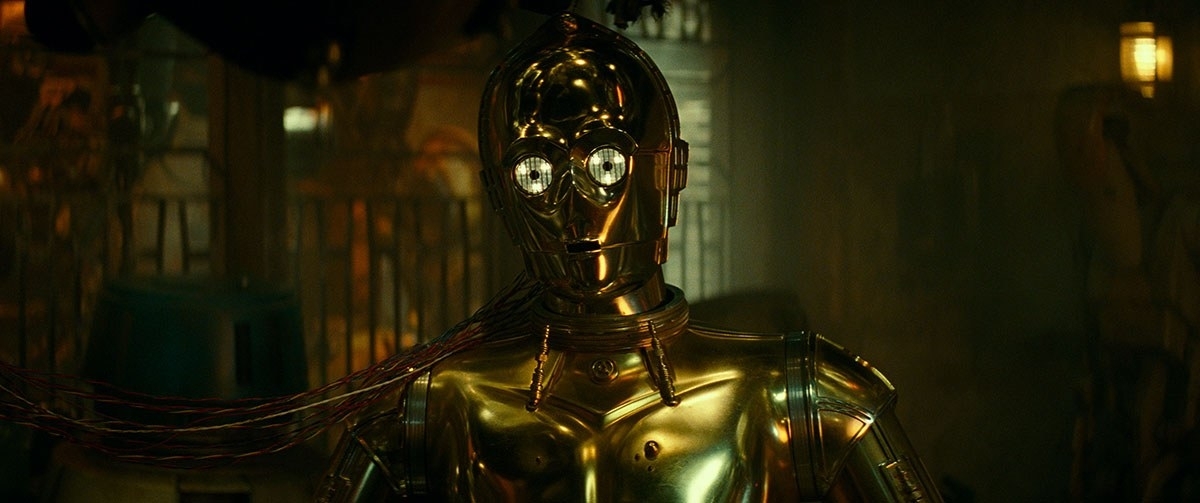
Anthony Daniels is C-3PO in "STAR WARS: THE RISE OF SKYWALKER." Photo by Lucasfilm. © 2019 and TM Lucasfilm Ltd. All Rights Reserved.
“Watch out for the close-ups of C-3PO in the warmly-lit interior of the Droid workshop,” he points to as just one example, “Using a 75mm Retro C, wide open at T2.8 and capturing on film, the bokeh looks almost like liquid, and the final image has incredible intimacy.”
Mindel shot the vast majority of the film’s interior/exterior scenes with just one stock, KODAK VISION3 500T Color Negative Film 5219, shooting uncorrected, harnessing KODAK VISION3 50D Color Negative Film 5203 for the sunlit desert scenes in Jordan and bright days in Black Park in the UK.
“Even after 40 years in the business, film technology still blows me away,” Mindel exclaims. “We had a multi-racial cast and both stocks gave all types of skin such lovely rendition and texture in the same frame.
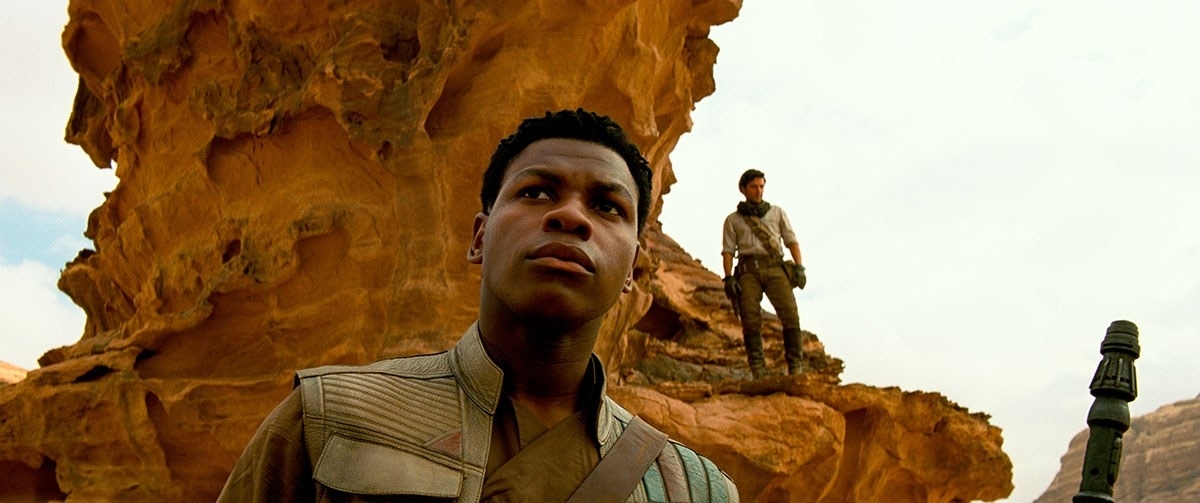
Finn (John Boyega) and Poe Dameron (Oscar Isaac) in "STAR WARS: THE RISE OF SKYWALKER." Photo by Lucasfilm Ltd. © 2019 ILM and Lucasfilm Ltd. All Rights Reserved.
“The 500T 5219 is probably my most favorite stock ever. Along with having fine grain, it is fast. You don’t need to use vast quantities of light to build stop, and it allowed me to control the aperture of the lenses in a very easy way. Additionally, its latitude meant I could shoot our many dark and scary scenes in low-level light and have confidence that any highlights would still register perfectly well.
“For its part, the 50D 5203 has fantastic contrast and is similarly super-pliable in terms of rendering details in the high and low-light areas of the image. You can let the highlights go by 3 or 4 stops and you will be OK. What a gift it was to be able to capture our desert scenes in winter sun on 50D. I think those sequences look absolutely fantastic in the final movie too.”
Film processing was completed at Kodak Film Lab, based on the Pinewood Studios’ lot. “I was serious about screening dailies before work every morning,” Mindel remarks. “The proximity of the lab meant we could process and scan the negative overnight, and then review and color the dailies in the 007 Theatre next morning. It’s a great way to work. It allowed me to make any adjustment to the on-set lighting for the coming day’s shoot, and for all other departments to evaluate and adjust their work accordingly as well.”
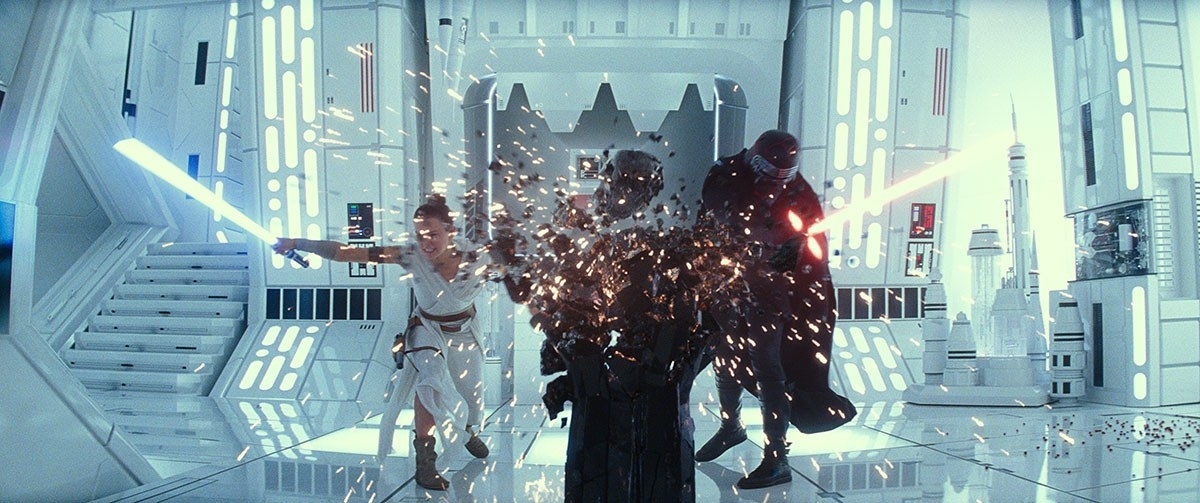
Daisy Ridley is Rey in "STAR WARS: THE RISE OF SKYWALKER." Photo by Lucasfilm. © 2019 and TM Lucasfilm Ltd. All Rights Reserved.
Obviously, with a galaxy-hopping sci-fi adventure such as Star Wars, seamless visual effects are vital to the suspension of disbelief, and Mindel enthuses that ILM, the lead VFX vendor on the movie, “knocked it out of the park – the computer generated VFX are stunning.
“Synthetic CG animated and VFX elements are crisp and clean when they are emitted from the computer and can often look false when combined with digital live action. But the improvements in film scanning, combined with post treatment using grain patterns and filmic emulations, mean that the CG and VFX elements blend incredibly well with the live action shot on celluloid. The results look real and alive, and you simply cannot see the join. There are times when I ask myself, ‘Did I shoot that for real, or did they generate that in post?’”
Mindel concludes: “I so happy that we shot Star Wars: The Rise of Skywalker on celluloid film. The result is visually-distinctive, as it should be. Also, as a cinematographer, film requires you really think about what you are doing. For youngsters participating in film’s renaissance around the world it’s an exciting time for them to make their mark. I would now love to see more directors reduce their inclination to go technical with digital and come back to the traditional nuts and bolts of filmmaking, to tell their stories with a simple film camera and aesthetics that really only film can deliver.”